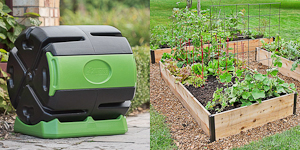- Home
- How to Grow Vegetables A-Z
- Growing Winter Squash
- Storing Winter Squash
Storing Winter Squash
Before storing winter squash for the season, you will need to put them through a process known as "curing", which can either be done on the ground in the garden (preferable), or in a warm dry place in the house.
Storing Winter Squash: Curing
"Curing" means giving the squash time to realize they are no longer
connected to their source of water and nourishment, which will put them into a
state of final ripening. Instead of continuing to grow more, they will start to convert their
starches to sugars, which will improve their flavor and shelf life. Leaving them out in the garden is preferable because the sun will warm them and accelerate the process.
After cutting the winter squashes from the vine (leaving a couple of inches of stem attached to the squash), just lay them on the ground in the garden or field and let them dry there for 5-7 days in the sun.
Exception: If cool or rainy weather threatens (or you live where the local squirrels have developed a taste for squash and their seeds), you can bring the squashes inside and place them in a sunny, warm, airy place in the house to cure.
After your winter squashes have cured for 5-7 days, you can bring them indoors. The ideal conditions for storing winter squash are often found in a basement or in a non-freezing garage – someplace where it will stay
cool but not cold. A stable temperature of 50-55 degrees F is ideal.
Storing winter squash for maximum shelf life also includes good air circulation, so it's best not to let them touch each other. This also helps prevent any decay that may hit one from spreading to the others.
As with any crop in storage, check your winter squashes frequently for signs of degradation like soft spots or mold. Compost any of these that you find.
Storing Winter Squash: Varietal Differences
Some varieties of squash taste better with a little age on them, and others are better eaten fresh.
Acorn and Spaghetti Squash are best eaten from harvest through about 10 weeks after harvest
Delicata Squash are best eaten from harvest through about 12 weeks after harvest
Kabocha and Non-green Hubbard Squash are best eaten from harvest through about 16 weeks after harvest
Buttercup & Larger, Green or Gray Kabocha Squash are best eaten after the first 4-6 weeks of storage, up through about 5-6 months after harvest
Hubbard & Butternut Squash are best eaten after 1-2 months of storage, up through about 4-6 months after harvest
Help share the skills and spread the joy
of organic, nutrient-dense vegetable gardening, and please...
~ Like us on Facebook ~
Thank you... and have fun in your garden!
Affiliate Disclaimer
This website contains affiliate links to a few quality products I can genuinely recommend. I am here to serve you, not to sell you, and I do not write reviews for income or recommend anything I would not use myself. If you make a purchase using an affiliate link here, I may earn a commission but this will not affect your price. My participation in these programs allows me to earn money that helps support this site. If you have comments, questions or concerns about the affiliate or advertising programs, please Contact Me.Contact Us Page



